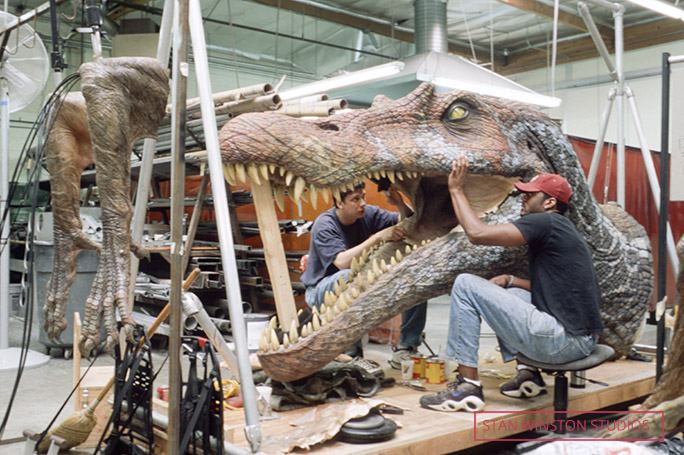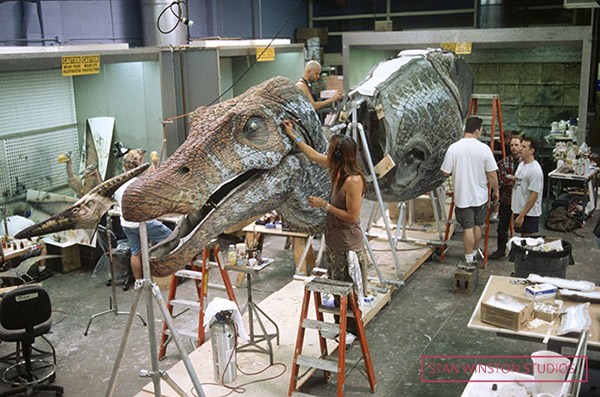
Meet Jurassic Park's Spinosaurus
A majestic creature of the past, the Spinosaurus ruled over what now is North Africa about 99 to 93.5 million years ago.
Although dinosaurs (luckily for us) don't roam the earth anymore, the predator was minutely recreated as a full-sized model for the 2021 blockbuster success Jurassic Park III, part of the cult 1993 franchise Jurassic Park.
Get up close and personal with this jaw-dropping, record-breaking predator that would go on to become the largest movie animatronic ever.

2023 marks the 30th anniversary of Steven Spielberg’s colossal Jurassic Park – and what better way to celebrate it than with a colossal record?
With a length of nearly 13.7m (45 ft), this majestic animal was the largest carnivorous dinosaur that ever existed. It could weight up to 6 tonnes, and is widely known to be a contender for the title of longest and largest theropod dinosaur ever.
It is no surprise, then, that the incredible dino would become the largest movie animatronic ever once recreated for the Stan Winston Studios.
The first step was to create a scaled-down, highly detailed model of the Spinosaurus. That would serve as a base for the much larger, much more complicated mechanical model.
From there, the special effects team would go on to create a massive replica of a true Spinosaurus – a roaring mechanical animal with crocodile-like eyes, ready to cause havoc on set.
In 1993, for the first movie, not all the animals were mechanized. Some of them had real actors inside, wearing a dino suit and allowing the animals to move: that is, for example, the case of the raptors.
But who was the real Spinosaurus, the majestic ruler of the rivers?
Originally from an area we would now identify as Africa, the first traces of the Spinosaurus were discovered in Egypt in 1912 and, later, described by German paleontologist Ernst Stromer in 1915.
However, it was not until the 21st century that we learned more about these giants of the past.
As new fossils were discovered, paleontologists all over the world gained a better understanding of this majestic beast – to the point that, today, we can recreate a mechanical replica that looks terrifyingly similar to the real deal.
The lizard-like dinosaur was part of the theropod family like the equally terrifying T-rex (perhaps the most famous of Jurassic Park’s stars): their family is characterized by their bipedal stance, sharp teeth, and an elongated skull similar to a crocodile.
The Jurassic Park team indeed based their very own Spinosaurus’s eyes on the ones of a real-life crocodile.
Speaking of crocs, have you met Cassius yet? He's the largest crocodile ever!
The Spinosaurus is set apart from their big carnivorous relatives thanks to their extraordinary adaptations for a semi-aquatic lifestyle. It led modern experts believe that this creature lived along rivers and lakes.
With elongated jaws filled with conical teeth, these dinosaurs were perfectly suited to catch fish and other aquatic prey. Their long snouts and narrow jaws are reminiscent of modern-day reptiles.
The most recognizable feature of remains, beyond doubt, the structure (also called hump) on its back.
Modern studies have suggested a variety of purposes for the impressive tail fin that bloomed on the back of the Spinosaurus.
Although some suggest that it could have served a purpose similar to the dorsal fins of sailfish, with an hydrodynamic purpose and aiding with hunting in the water, other experts tend to believe that is was probably utilized more for display and species recognition rather than swimming.
For Jurassic Park’s Spinosaurus, the majestic sail-like structure was made of rubber and foam.
This water-dwelling predator has sparked, and continues to ignite, numerous debates among scientists.
In the meantime, 99 millions of years after the time when this majestic beast roamed the earth, the cinematic sensation Jurassic Park continues to break records.
To this day, Steven Spielberg’s game-changing blockbuster remains the highest-grossing dinosaur franchise ever.
The 2015 sequel Jurassic World, set in the same universe of Jurassic Park, became the highest-grossing dinosaur movie ever.
And did you know that, despite being the stars of the franchise, in the first 1993 movie the dinosaurs only appear for 15 minutes, while the film clocks at 127 minutes runtime?
They're barely present, yet they are unforgettable!



